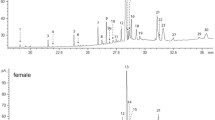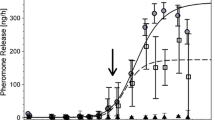Abstract
Males of the parasitic wasp Nasonia vitripennis (Hymenoptera: Pteromalidae) use a substrate-borne sex pheromone to attract virgin females. The pheromone is synthesized in the rectal vesicle and deposited via the anus by dabbing movements of the abdominal tip. The chemicals attracting the females are composed of a mixture (4R,5R- and (4R,5 S)-5-hydroxy-4-decanolides (HDL) being synergized by the trace component 4-methylquinazoline (4-MeQ) which is not attractive for females when offered alone. Here we show that male pheromone deposits are not only attractive to virgin females but also for the releasing males themselves. In an olfactometer bioassay, males were strongly attracted by their own pheromone markings but were unable to discriminate between their own markings and those deposited by other males. Polar fractions of pheromone gland extracts containing the HDLs and 4-MeQ were also highly attractive for males. Bioassays using synthetic pheromones in natural doses revealed that combinations of HDL/4-MeQ and 4-MeQ alone attracted males whereas the HDLs alone were behaviorally inactive. Furthermore, males did not discriminate between HDL/4-MeQ and 4-MeQ alone. We conclude that the trace component 4-MeQ mediates site fidelity of N. vitripennis males at sites previously marked with the abdominal sex pheromone. The use of 4-MeQ to stay at and to return to scent-marked patches rather than marking new ones might be a strategy to economize semiochemical use in N. vitripennis males.


Similar content being viewed by others
References
Abdel-latief, M., Garbe, L. A., Koch, M., and Ruther, J. 2008. An epoxide hydrolase involved in the biosynthesis of an insect sex attractant and its use to localize the production site. Proc. Natl. Acad. Sci. USA 105:8914-8919.
Baker, R. R. 1983. Insect Territoriality. Annu. Rev. Entomol. 28:65–89.
Barras, R. 1969. Preening and abdomen dipping by the male Mormoniella vitripennis (Walker) (Hymenoptera, Pteromalidae) after courtship. Behaviour 35:304–312.
Bergmann, J., Brynolf, A., Elman, B., and Vuorinen, E. 1986. Synthesis of quinazolines. Tetrahedron 42:3697–3706.
Borgeson, C. E., Kurtti, T. J., Munderloh, U. G., and Blomquist, G. J. 1991. Insect tissues not microorganisms produce linoleic acid in the house cricket and the American cockroach. Experientia 47:238–241.
Garbe, L. A. and Tressl, R. 2003. Metabolism of deuterated isomeric 6,7-dihydroxydodecanoic acids in Saccharomyces cerevisiae— diastereo- and enantioselective formation and characterization of 5-hydroxydecano-4-lactone (= 4,5-dihydro-5-(1-hydroxyhexyl)furan-2(3H)-one) isomers. Helv. Chim. Acta 86:2349–2363.
Johansson, B. J. and Jones, T. M. 2007. The role of chemical communication in mate choice. Biological Reviews 82:265–289.
Kroiss, J., Lechner, K., and Strohm, E. 2010. Male territoriality and mating system in the European beewolf Philanthus triangulum F. (Hymenoptera: Crabronidae): evidence for a “hotspot” lek polygyny. J. Ethol. 28:295–304.
Leonard, J. E. and Boake, C. R. B. 2006. Site-dependent aggression and mating behaviour in three species of Nasonia (Hymenoptera: Pteromalidae). Anim. Behav. 71:641–647.
Raw, A. 1975. Territoriality and scent marking by Centris males in Jamaica. Behaviour 54: 311–321.
Ruther, J., Stahl, L. M., Steiner, S., Garbe, L.A., and Tolasch, T. 2007. A male sex pheromone in a parasitic wasp and control of the behavioral response by the female’s mating status. J. Exp. Biol. 210:2163–2169.
Ruther, J., Steiner, S., and Garbe, L. A. 2008. 4-Methylquinazoline is a minor component of the male sex pheromone in Nasonia vitripennis. J. Chem. Ecol. 34:1–4.
Ruther, J., Matschke M., Garbe, L. A., and Steiner, S. 2009. Quantity matters: male sex pheromone signals mate quality in the parasitic wasp Nasonia vitripennis. Proc. R. Soc. Lond. B 276: 3303–3310.
Steiner, S. and Ruther, J. 2009. Mechanism and behavioral context of male sex pheromone release in Nasonia vitripennis. J. Chem. Ecol. 35: 416–421.
Van den Assem, J. 1986. Mating behaviour in parasitic wasps, pp. 137–167, in J. Waage and D. Greathead (eds.). Insect parasitoids. Academic Press, London.
Van den, Assem, J., Gijswijt, M. J., and Nübel, B. K. 1980a. Observations on courtship and mating strategies in a few species of parasitic wasps (Chalcidoidea). Neth. J. Zool. 30:208–227.
Van den Assem, J., Jachmann, F., and Simbolotti, P. 1980b. Courtship behaviour of Nasonia vitripennis (Hym., Pteromalidae): Some qualitative experimental evidence for the role of pheromones. Behaviour 75:301–307.
Wathes, D. C., Abayasekara, D. R. E., and Aitken, R. J. 2007. Polyunsaturated fatty acids in male and female reproduction. Biol. Reprod. 77:190–201.
Weinert, J., Blomquist, G. J., and Borgeson, C. E. 1993 De-novo biosynthesis of linoleic acid in two non-insect invertebrates— the land slug and the garden snail. Experientia 49:919–921.
Wertheim, B., van Baalen, E.-J. A., Dicke, M., and Vet, L. E. M. 2005. Pheromone-mediated aggregation in non-social arthropods: an evolutionary ecological perspective. Annu. Rev. Entomol. 50:321–346.
Whiting, A. R. 1967. The biology of the parasitic wasp Mormoniella vitripennis. Q. Rev. Biol. 42:333–406.
Wyatt, T. D. 2003. Pheromones and Animal Behaviour: Communication by Smell and Taste. P. 391. Cambridge University Press, Cambridge.
Acknowledgements
This research was funded by the Deutsche Forschungsgemeinschaft (DFG, grant Ru 717/10-1). The authors thank Birgit Blaul for her help in producing the supplementary online material and two anonymous reviewers for helpful comments.
Author information
Authors and Affiliations
Corresponding author
Electronic Supplementary Material
Below is the link to the electronic supplementary material.
The video shows a Nasonia vitripennis male depositing the abdominal sex pheromone by dabbing movements of the abdominal tip. (MP4 1287 kb)
Rights and permissions
About this article
Cite this article
Ruther, J., Thal, K. & Steiner, S. Pheromone Communication in Nasonia vitripennis: Abdominal Sex Attractant Mediates Site Fidelity of Releasing Males. J Chem Ecol 37, 161–165 (2011). https://doi.org/10.1007/s10886-010-9898-8
Received:
Revised:
Accepted:
Published:
Issue Date:
DOI: https://doi.org/10.1007/s10886-010-9898-8




